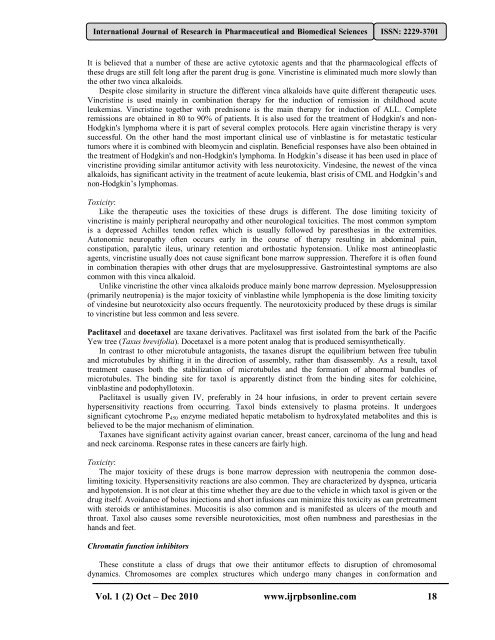Monitoring of Suspected Adverse Drug Reactions in Oncology Unit ...
Monitoring of Suspected Adverse Drug Reactions in Oncology Unit ...
Monitoring of Suspected Adverse Drug Reactions in Oncology Unit ...
You also want an ePaper? Increase the reach of your titles
YUMPU automatically turns print PDFs into web optimized ePapers that Google loves.
International Journal <strong>of</strong> Research <strong>in</strong> Pharmaceutical and Biomedical Sciences ISSN: 2229-3701<br />
It is believed that a number <strong>of</strong> these are active cytotoxic agents and that the pharmacological effects <strong>of</strong><br />
these drugs are still felt long after the parent drug is gone. V<strong>in</strong>crist<strong>in</strong>e is elim<strong>in</strong>ated much more slowly than<br />
the other two v<strong>in</strong>ca alkaloids.<br />
Despite close similarity <strong>in</strong> structure the different v<strong>in</strong>ca alkaloids have quite different therapeutic uses.<br />
V<strong>in</strong>crist<strong>in</strong>e is used ma<strong>in</strong>ly <strong>in</strong> comb<strong>in</strong>ation therapy for the <strong>in</strong>duction <strong>of</strong> remission <strong>in</strong> childhood acute<br />
leukemias. V<strong>in</strong>crist<strong>in</strong>e together with prednisone is the ma<strong>in</strong> therapy for <strong>in</strong>duction <strong>of</strong> ALL. Complete<br />
remissions are obta<strong>in</strong>ed <strong>in</strong> 80 to 90% <strong>of</strong> patients. It is also used for the treatment <strong>of</strong> Hodgk<strong>in</strong>'s and non-<br />
Hodgk<strong>in</strong>'s lymphoma where it is part <strong>of</strong> several complex protocols. Here aga<strong>in</strong> v<strong>in</strong>crist<strong>in</strong>e therapy is very<br />
successful. On the other hand the most important cl<strong>in</strong>ical use <strong>of</strong> v<strong>in</strong>blast<strong>in</strong>e is for metastatic testicular<br />
tumors where it is comb<strong>in</strong>ed with bleomyc<strong>in</strong> and cisplat<strong>in</strong>. Beneficial responses have also been obta<strong>in</strong>ed <strong>in</strong><br />
the treatment <strong>of</strong> Hodgk<strong>in</strong>'s and non-Hodgk<strong>in</strong>'s lymphoma. In Hodgk<strong>in</strong>’s disease it has been used <strong>in</strong> place <strong>of</strong><br />
v<strong>in</strong>crist<strong>in</strong>e provid<strong>in</strong>g similar antitumor activity with less neurotoxicity. V<strong>in</strong>des<strong>in</strong>e, the newest <strong>of</strong> the v<strong>in</strong>ca<br />
alkaloids, has significant activity <strong>in</strong> the treatment <strong>of</strong> acute leukemia, blast crisis <strong>of</strong> CML and Hodgk<strong>in</strong>’s and<br />
non-Hodgk<strong>in</strong>’s lymphomas.<br />
Toxicity:<br />
Like the therapeutic uses the toxicities <strong>of</strong> these drugs is different. The dose limit<strong>in</strong>g toxicity <strong>of</strong><br />
v<strong>in</strong>crist<strong>in</strong>e is ma<strong>in</strong>ly peripheral neuropathy and other neurological toxicities. The most common symptom<br />
is a depressed Achilles tendon reflex which is usually followed by paresthesias <strong>in</strong> the extremities.<br />
Autonomic neuropathy <strong>of</strong>ten occurs early <strong>in</strong> the course <strong>of</strong> therapy result<strong>in</strong>g <strong>in</strong> abdom<strong>in</strong>al pa<strong>in</strong>,<br />
constipation, paralytic ileus, ur<strong>in</strong>ary retention and orthostatic hypotension. Unlike most ant<strong>in</strong>eoplastic<br />
agents, v<strong>in</strong>crist<strong>in</strong>e usually does not cause significant bone marrow suppression. Therefore it is <strong>of</strong>ten found<br />
<strong>in</strong> comb<strong>in</strong>ation therapies with other drugs that are myelosuppressive. Gastro<strong>in</strong>test<strong>in</strong>al symptoms are also<br />
common with this v<strong>in</strong>ca alkaloid.<br />
Unlike v<strong>in</strong>crist<strong>in</strong>e the other v<strong>in</strong>ca alkaloids produce ma<strong>in</strong>ly bone marrow depression. Myelosuppression<br />
(primarily neutropenia) is the major toxicity <strong>of</strong> v<strong>in</strong>blast<strong>in</strong>e while lymphopenia is the dose limit<strong>in</strong>g toxicity<br />
<strong>of</strong> v<strong>in</strong>des<strong>in</strong>e but neurotoxicity also occurs frequently. The neurotoxicity produced by these drugs is similar<br />
to v<strong>in</strong>crist<strong>in</strong>e but less common and less severe.<br />
Paclitaxel and docetaxel are taxane derivatives. Paclitaxel was first isolated from the bark <strong>of</strong> the Pacific<br />
Yew tree (Taxus brevifolia). Docetaxel is a more potent analog that is produced semisynthetically.<br />
In contrast to other microtubule antagonists, the taxanes disrupt the equilibrium between free tubul<strong>in</strong><br />
and microtubules by shift<strong>in</strong>g it <strong>in</strong> the direction <strong>of</strong> assembly, rather than disassembly. As a result, taxol<br />
treatment causes both the stabilization <strong>of</strong> microtubules and the formation <strong>of</strong> abnormal bundles <strong>of</strong><br />
microtubules. The b<strong>in</strong>d<strong>in</strong>g site for taxol is apparently dist<strong>in</strong>ct from the b<strong>in</strong>d<strong>in</strong>g sites for colchic<strong>in</strong>e,<br />
v<strong>in</strong>blast<strong>in</strong>e and podophyllotox<strong>in</strong>.<br />
Paclitaxel is usually given IV, preferably <strong>in</strong> 24 hour <strong>in</strong>fusions, <strong>in</strong> order to prevent certa<strong>in</strong> severe<br />
hypersensitivity reactions from occurr<strong>in</strong>g. Taxol b<strong>in</strong>ds extensively to plasma prote<strong>in</strong>s. It undergoes<br />
significant cytochrome P 450 enzyme mediated hepatic metabolism to hydroxylated metabolites and this is<br />
believed to be the major mechanism <strong>of</strong> elim<strong>in</strong>ation.<br />
Taxanes have significant activity aga<strong>in</strong>st ovarian cancer, breast cancer, carc<strong>in</strong>oma <strong>of</strong> the lung and head<br />
and neck carc<strong>in</strong>oma. Response rates <strong>in</strong> these cancers are fairly high.<br />
Toxicity:<br />
The major toxicity <strong>of</strong> these drugs is bone marrow depression with neutropenia the common doselimit<strong>in</strong>g<br />
toxicity. Hypersensitivity reactions are also common. They are characterized by dyspnea, urticaria<br />
and hypotension. It is not clear at this time whether they are due to the vehicle <strong>in</strong> which taxol is given or the<br />
drug itself. Avoidance <strong>of</strong> bolus <strong>in</strong>jections and short <strong>in</strong>fusions can m<strong>in</strong>imize this toxicity as can pretreatment<br />
with steroids or antihistam<strong>in</strong>es. Mucositis is also common and is manifested as ulcers <strong>of</strong> the mouth and<br />
throat. Taxol also causes some reversible neurotoxicities, most <strong>of</strong>ten numbness and paresthesias <strong>in</strong> the<br />
hands and feet.<br />
Chromat<strong>in</strong> function <strong>in</strong>hibitors<br />
These constitute a class <strong>of</strong> drugs that owe their antitumor effects to disruption <strong>of</strong> chromosomal<br />
dynamics. Chromosomes are complex structures which undergo many changes <strong>in</strong> conformation and<br />
Vol. 1 (2) Oct – Dec 2010 www.ijrpbsonl<strong>in</strong>e.com 18

















